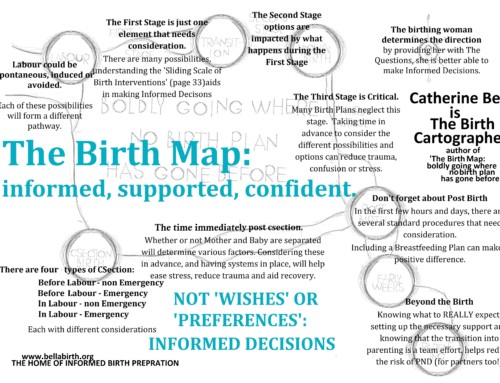There was a time when the idea was that once you had one c-section, you were doomed to repeat it over and over for as many children as you had. However, while things had been changing in North America with more and more women are undergoing what is known as the VBAC, or vaginal birth after caesarean, the trend has reversed with VBACs declining in the US, reaching the lowest amongst a comparison of 14 industrialized nations with a rate of 8.2% (the next lowest is Lithuania at 19%; the highest being the Netherlands with 55%)
Medical Considerations
Lucky for us, there has been a lot of research on VBACs, which means I will limit results to meta-analyses, reviews, and large scale studies when possible as they provide the best information. In a large meta-analysis and review of the literature on outcomes specific to either VBAC or ERCD (Elected Repeat Caesarean Delivery) (thus not including the outcomes pertinent to c-sections more generally), the authors found the following outcomes[2]:
- Rate of actual vaginal delivery ranged from 60 to 82%, but the use of oxytocin to induce or augment labour reduced the chance of a successful VBAC by 10%
- The use of x-ray pelvimetry to predict whether or not a woman would be successful in her VBAC (looking at the potential route of delivery) was inefficient in reliably predicting delivery method
- Maternal mortality and hysterectomy rates do not differ between VBAC and ERCD women
- There is a greater overall risk of infection in having an ERCD over VBAC; however, women who attempted a VBAC but ended up with a c-section also showed increased infection rates
- There was an increased risk of perinatal morality associated with VBACs (though there’s conflicting evidence of the magnitude, but it was increased in both large scale studies found that examined the question indirectly); however, there was insufficient evidence to suggest a difference in infant mortality was due to this particular choice versus other factors (no study measured infant death attributable to the choice of VBAC versus ERCD)
- Asymptomatic uterine rupture was equal between both groups, but symptomatic uterine rupture is nearly 3 times higher in women undergoing a VBAC
- No good studies examined patient satisfaction as an outcome, however, for a successful VBAC (actually when the probability of success is 76% or higher – determined using a standardized checklist upon arrival at the hospital with 10 symptomatic questions), the cost is less and the quality of life is higher
Importantly, there were some caveats to these outcomes. Specifically, some of the factors that were found to influence success of the VBAC were: maternal age less than 40 (increase), prior vaginal delivery (increase), nonrecurrent indication for the prior c-section (increase), favourable cervical factors (increase), more than 1 c-section (decrease), gestational age greater than 40 weeks (decrease), and augmentation of labour (decrease).
One thing the meta-analysis failed to examine though was risk factor. Indeed, in a study looking at all births in the US between 1998 and 2002 and dividing births up into risk category, certain differences emerged. When only low-risk births were considered, having a repeat cesarean increased the risk of neonatal death by approximately 36% (compared to a VBAC) and there was an approximately 20% increased risk of neonatal death for ‘no indicated risk’ women (again, compared to a VBAC)[3]. Unfortunately because it was national data, the confounds that can be included in systematic studies were unavailable (e.g., age, prior vaginal delivery). Notably, the fact that a woman may have had a prior vaginal birth seems to make a huge difference, and yet it was a factor that was ignored for a long time when examining success or failure of a VBAC.
Luckily more recent research has examined the protective benefit, so to speak, of a prior vaginal birth on VBAC safety. In a large scale study (including over 6600 women), researchers examined the effect of a prior vaginal birth on outcomes known to be greater in VBACs, including uterine rupture, bladder injury, a composite (including uterine rupture, bladder injury, uterine artery laceration, and bowel injury), fever, and transfusion[4]. Even without controlling for confounding factors, none of these morbidities was greater for VBAC versus ERCD (and remained non-significant – in fact the effect size decreased – when controlling for confounding factors) in women with a prior vaginal delivery. Compared to women in the trial who had not had a prior vaginal delivery, the decreases were most significant for uterine rupture and the composite (which were significantly greater in VBACs in this group).
Some might argue, however, that any increased risk is not worth it. Namely because the largest concern is uterine rupture, which has dire consequences for both mother and baby. More recent research suggests the overall rates of uterine rupture in both VBAC and ERCD are decreasing[5]. Furthermore, while there is an increased risk of uterine rupture in VBACs, there is an increased risk of placenta previa in repeat c-sections, an outcome that is also life-threatening to both mother and baby, but has received far less attention[5]. Interestingly, a systematic review examining the outcomes of VBAC-2 versus a third c-section found that while the increased risk of uterine rupture remained (though again was dampened by a prior vaginal birth), there was no difference in any other maternal morbidity conditions[6].
One consideration that must be made when we compare these outcomes (or even planned outcomes) is who is getting a VBAC. In a review of data from 22 states (in the US) in 2007, it was found that VBACs were more common for women with less education, for subsequent children (i.e., if this was the 3rd or 4th child, presumably because of a previous vaginal birth), and for certain ethnicities (e.g., American Indian, Non-Hispanic Black)[1]. (Ethnicity is interesting, though, as one large cohort study has shown that while Black women are more likely to have a failed VBAC attempt, they are 40% less likely to have a uterine rupture[7]. Future research would into what is acting as a protective factor there would be quite useful.) Notably, one concern is that nearly 20% of women who had a VBAC had no prenatal care[1], despite the higher risks associated with it in the United States. This lack of prenatal care may affect some of the risks associated with a VBAC as it means certain conditions may go unnoticed until a woman has gone into labour.
In sum, it seems that there are some concerns for VBACs; however they are tempered by many other factors that need to be considered. Additionally, having a second c-section is not all sunshine and rainbows either—there are possible negative repercussions physically (e.g., placenta previa) and women are still subject to some of the ill-effects discussed in the article on c-sections more generally.
Emotional Considerations
Sadly there is not a wealth of information on women’s experiences emotionally to a VBAC or ERCD except a reporting that many women find VBACs to be positive when successful (though it’s never compared to the experience of a woman with an ERCD). Most studies are small scale in nature, but some findings seem somewhat clear (or as clear as can be from small scale studies). First, women who are in control and able to make their own decision of type of delivery (whichever they choose) report more positive outcomes than those who have the choice taken away from them[8]. However, this is qualified by the fact that many women feel as though they are not provided with adequate information regarding the risks and benefits of each form of delivery, and when this is the case, women are prone to feelings of anxiety regarding their decisions[8][9][10][11].
Second, most women do feel quite positive in their experience of a successful VBAC compared to their previous c-section, as well as reporting more adaptive responses with respect to parenting[12]; however, what has not been compared is how this compares to women who select an ERCD. While some might believe that the outcomes with respect to c-sections covered previously would apply again, arguably they might not. A woman who has to undergo a second c-section may very well be more mentally prepared for it and thus better able to cope post-partum. Unfortunately, there is not the requisite research to guide us on this question.
Finally, what of women for whom the attempted VBAC failed? One study examined women’s feelings about their experience after a failed VBAC and found that previous births mattered[13]. That is, a woman who had had a successful vaginal birth prior to this VBAC attempt was able to view the attempt in a positive light. However, when no such vaginal birth had taken place, the experience could become quite traumatic and negative for the woman. Furthermore, many women reported frustration at the limited options provided to them by their caregivers.
While the VBAC has generally provided women with positive experiences, it is dependent upon a successful VBAC and women being able to make a choice based on non-biased risk and benefit assessments. What is unknown still is how this compares to emotions for women who select an ERCD. I would personally imagine that the reason for selection would play a huge role in these feelings – is a woman selecting an ERCD because that’s the only option her caregiver has given her? Or is she aware of all risks and benefits and is making the decision she believes best for herself? In the former case, I would imagine a negative experience may result, but not in the latter. And this research is simply unavailable, leaving questions open as to what services are most needed for women facing a pregnancy after a c-section.
Conclusions
The VBAC can be a very positive experience for women provided it goes as planned. However, there are elements of risk and women need to be given unbiased information about the risks and benefits of either a VBAC or an ERCD to enable them to make the best choice for them. Unfortunately, in many countries this information is not given or only selectively given, making many women feel as though their pregnancy and birth is out of their control. It is also unfortunate that one of the biggest risk factors is how the internal stitching was done for the original c-section and yet people have no idea how theirs was. Some hospitals do actually keep records of who did the sutchering and the rate of rupture for subsequent VBACs, but they won’t release this information for very obvious legal reasons. However, I would say it’s always worth trying to look into if you can.
We also need much more support in place given that one’s planned decision may not always come to pass and can be very traumatic for women. This seems to be particularly true for the failed VBAC, which in essence means the woman is having an emergency c-section and there is ample evidence of negative psychosocial outcomes associated with the emergency c-section for many women. Finally, we need much more research into the factors that influence the likelihood of a successful VBAC (though we’ve started identifying some – like a previous vaginal birth) and the psychosocial outcomes of both a VBAC and an ERCD in order to provide women with even better information for which to make their decision.
[1] MacDorman M, Declercq E, Menacker F. Recent trends and patterns in cesarean and vaginal birth after cesarean (VBAC) deliveries in the United States. Clinics in Perinatology 2011; 38: 179-192.
[2] Guise JM, McDonagh MS, Hashima J, Kraemer DF, Eden KB, Berlin M, et al. Vaginal birth after cesarean (VBAC): Summary. AHRQ Evidence Report Summaries 2003; 03-E017.
[3] Menacker F, MacDorman MF, Declercq E. Neonatal mortality risk for repeat cesarean compared to vaginal birth after cesarean (VBAC) deliveries in the United States, 1998-2002 birth cohorts. Maternal & Child Health Journal 2010; 14: 147-54.
[4] Cahill AG, Stamilio DM, Odibo AO, Peipert JF, Ratcliffe SJ, Stevens EJ, et al. Is vaginal birth after cesarean (VBAC) or elective repeat cesarean safer in women with a prior vaginal delivery? American Journal of Obstetrics & Gynecology 2006; 195: 1143-7.
[5] Spong CY. To VBAC or not to VBAC. PLoS Med 2012; e1001191. doi:10.1371/journal.pmed.1001191
[6] Tahseen S, Griffiths M. Vaginal birth after two cesarean sections (VBAC-2)—a systematic review with meta-analysis of success rate and adverse outcomes of VBAC-2 versus VBAC-1 and repeat (third) caesarean sections. BJOG 2010; 117: 5-19.
[7] Cahill AG, Stamilio DM, Obido AO, Peipert JF, Stevens E, Macones GA. Racial disparity in the success and complications of vaginal birth after cesarean delivery. Obstetric Anesthesia Digest 2009; 29: 71-2.
[8] Fenwick J, Gamble J, Mawson J. Women’s experiences of a caesarean section and vaginal birth after caesarean: A birthrights initiative. International Journal of Nursing Practice 2003; 9: 10-7.
[9] Emmett CL, Shaw ARG, Montgomery AA, Murphy DJ. Women’s experience of decision making about mode of delivery after a previous caesarean section: the role of health professionals and information about health risks. BJOG 2006; 113: 1438-45.
[10] Meddings F, Phipps FM, Haith-Cooper M, Haigh J. Vaginal birth after caesarean section (VBAC): exploring women’s perceptions. Journal of Clinical Nursing 2007; 16: 160-7.
[11] McGrath P, Phillips E, Vaughan G. Vaginal birth after caesarean risk decision making: Australian findings on mothers’ perspective. International Journal of Nursing Practice 2010; 16: 274-81.
[12] Fawcett J, Tulman L, Spedden JP. Responses to vaginal birth after cesarean section. Journal of Obstetric, Gynecology, & Neonatal Nursing 1994; 23: 253-9.
[13] Chigbu CO, Enwereji JO, Ikeme AC. Women’s experiences following failed vaginal birth after cesarean delivery. International Journal of Gynecology & Obstetrics 2007; 99: 113-6.







Leave A Comment